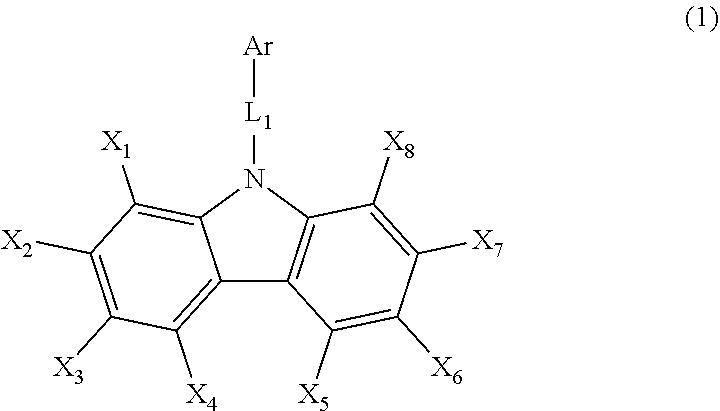Organic electroluminescent compound, a plurality of host materials, and organic electroluminescent device comprising the same
- Summary
- Abstract
- Description
- Claims
- Application Information
AI Technical Summary
Benefits of technology
Problems solved by technology
Method used
Image
Examples
Example
Device Examples 1, 2, and 5 to 12: Producing an OLED by Co-Evaporating the First and Second Host Compounds According to the Present Disclosure
[0074]An OLED according to the present disclosure was produced as follows: A transparent electrode indium tin oxide (ITO) thin film (10 Ω / sq) on a glass substrate for an OLED (GEOMATEC CO., LTD., Japan) was subjected to an ultrasonic washing with trichloroethylene, acetone, ethanol and distilled water, sequentially, and then was stored in isopropanol. The ITO substrate was mounted on a substrate holder of a vacuum vapor deposition apparatus. Compound HI-1 was introduced into a cell of the vacuum vapor deposition apparatus, and then the pressure in the chamber of the apparatus was then controlled to 10$ torr. Thereafter, an electric current was applied to the cell to evaporate the above-introduced material, thereby forming a first hole injection layer having a thickness of 80 nm on the ITO substrate. Next, compound HI-2 was introduced into anot...
Example
Device Example 3: Producing an OLED by Mixture-Evaporating the First and Second Host Compounds According to the Present Disclosure
Example
[0075]An OLED was produced in the same manner as in Device Example 2, except that the first host compound and the second host compound described in Table 1 were deposited in one cell rather than in two cells in a vacuum deposition apparatus.
PUM
 Login to View More
Login to View More Abstract
Description
Claims
Application Information
 Login to View More
Login to View More - R&D Engineer
- R&D Manager
- IP Professional
- Industry Leading Data Capabilities
- Powerful AI technology
- Patent DNA Extraction
Browse by: Latest US Patents, China's latest patents, Technical Efficacy Thesaurus, Application Domain, Technology Topic, Popular Technical Reports.
© 2024 PatSnap. All rights reserved.Legal|Privacy policy|Modern Slavery Act Transparency Statement|Sitemap|About US| Contact US: help@patsnap.com










